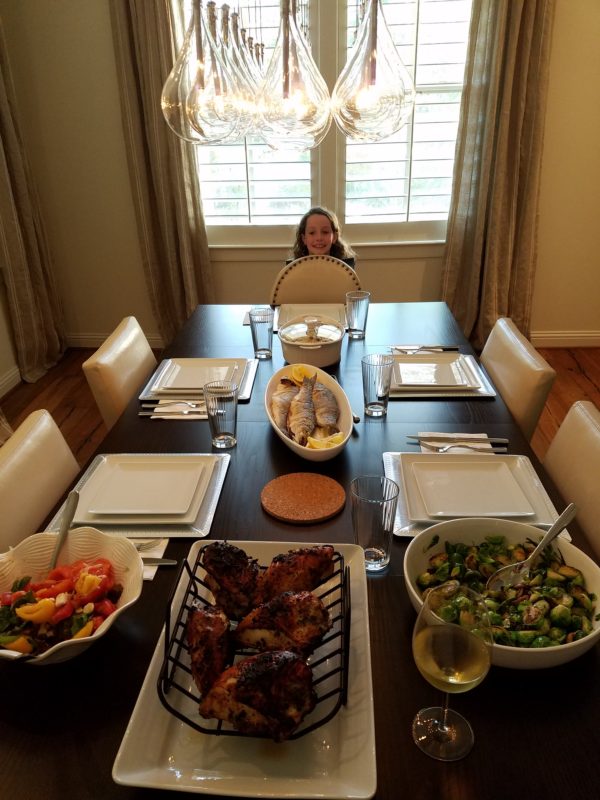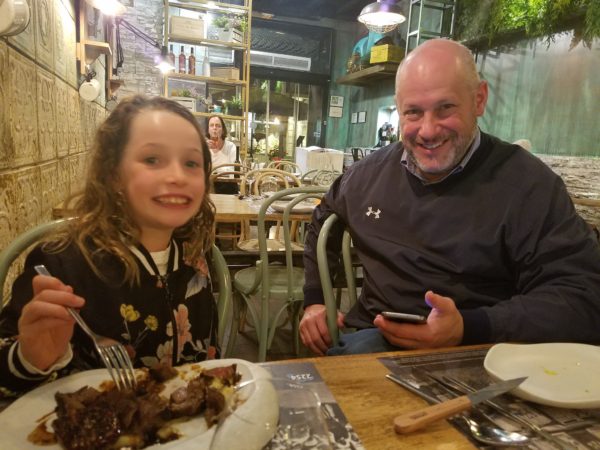Tips & Tricks for Traveling with Food Allergies
by Dr. Deirdre Hahn, Lifestyle Contributor | Eight years have passed since our daughter Lilly was tested for food allergies. We’ve adapted… but it shapes every single decision we make about eating. Every. Single. Decision. From buying a box of cereal to eating dinner while on vacation in Spain, we assess the risk of every morsel that may pass her lips. Sometimes it’s easy. In the United States, a box of cereal has a nice, clear label that lists ingredients and possible cross-contamination with other allergens. In other countries, this information may be missing from the label.
The following 8 foods account for 90% of all food allergic reactions in the U.S. per the Food & Drug Administration: milk, eggs, fish, shellfish, tree nuts, peanuts, wheat and soybeans. In 1950, food allergies were almost unheard of, and researchers generally agree that the dramatic increase of food allergies are the result of some combination of advances in food processing, better hygiene and disease control, and changes in gut bacteria.
Lilly at a friend’s house for dinner.
Food allergies require constant attention, which can be tough even in the best circumstances. This means traveling and eating away from home necessitates a level of planning that goes beyond picking the right shoes to pack.
One of the questions I’m frequently asked about having a child with a nut allergy is “how does traveling with food allergies actually work?” Well, here’s how we go about it to avoid having a problem. Once we know our destination, I start our planning process backwards.
Visiting the zoo in Fort Worth, Texas.
My Checklist
√ Research restaurant menus in the area we will be staying.
√ Download and read menus and nutrition information published for the restaurants we may visit.
√ Check the menu for potential hazards and determine the level of risk.
√ Make meal reservations when possible, and inform the hostess of the food allergies ahead of time.
√ Locate “safe” places we know we can eat in case we get into a pinch (i.e., Chipotle or a pizza place).
√ Print allergy travel cards to show to the waitperson when ordering.**
** This is one of the most valuable resources we have found for going out to eat — printable or laminated translation cards (in 65 languages!!) for food and drug allergies, special diets and medical needs. These cards can be shared with wait and kitchen staff for clear communication of any food restrictions. We used these cards on a recent trip to Europe and we found restaurant staff very appreciative of the clarity.
√ Map the local grocery stores for snacks.
√ Check the TSA website to understand what food is allowed through security. (This can be very different when travelling between countries outside of the U.S.)
√ Go online or call the airline about their nut policy. (These seem to change every few years.)
√ Purchase TSA-approved snacks to eat while waiting in the airport and to bring on the plane.
A few of our favorite nut-free travel snacks.
But, let me be honest, the checklist above evolved over many years of figuring out what worked for us. We certainly had some crazy close calls. When Lilly was two we flew from Singapore to Shanghai and Lilly was napping shortly after take off. The in-service started and suddenly all the rows ahead of us started opening their little snack bags…wait for it…of peanuts! The entire plane was served bags of peanuts and smell was overwhelming. We gave each other a horrified look and helplessly stared at Lilly, waiting for her to react. She slept through the whole thing. We quickly wiped down our entire area with antibacterial wipes and she never woke up and never had a reaction. Whew.
I’m convinced that the anxiety of that trip caused Dave and I to lose five years off our lives. What did we learn? First, we won’t fly without checking the airline snack policy, and second, Lilly didn’t have a reaction to airborne peanut particles — that time. She has reacted to peanuts in her environment since then, but that is a different story. Food allergy awareness has come a long way in the last eight years, but being prepared still goes a long way to mitigating the challenges of traveling with food restrictions.
Lilly and Dave enjoy a late dinner out in Barcelona.
Read more about Deirdre and her family’s journey with food allergies.
Do you have any tips to share on living with food allergies? Let us know in the comments section below!
2 responses to “Tips & Tricks for Traveling with Food Allergies”
Leave a Reply
-

Outshine on the Circuit
-

Mom Muse | Danielle McPartlin
-

Ask Our Style Techs | Considering a Crop Top
-

These Cute Pajamas Help Homeless Kids
-

Lust. Luxe. Less. | Crochet Chic
-

Ask Our Style Techs |On-the-Run Fashion Fixes
-

Who’s Your Valentine? Dress the Part
-

Wear Teal and Stand Up to Ovarian Cancer
-

Video | Glamorize with Accessories
-

Video | Top 5 Spring Shoe Trends










Hi, I have a son that has a severe peanut allergy and he is also allergic to cow’s milk. I also have two other kids but they don’t have food allergies. My son is 5 years old and it has been really challenging I have been so over protective. He will start kindergarten in just few days. I’m scared I feel like I’m just sending him out in the world all by himself. Can you please give me any advice?
Hello!
I understand your concern. My daughter, who will be 11 soon, was diagnosed with a severe peanut, tree nut and sesame allergy when she was 1. I remember preparing to send her to pre-school for the first time. I was out of my mind with anxiety because, like you, I was over-protective. My advice is to over-prepare! It’s been 7 years since her first day of school and what I’m going to recommend is based upon what I’ve learned over the years.
Here are some steps to help we took to make a safe and smooth transition from home to school.
1) I met with my daughter’s allergist. We obtained epi pens and her doctor gave me form that had a step-by-step guide for recognizing symptoms and responding to an allergic reaction. I made several copies of this form.
2) I met with her teacher, the school nurse, the cafeteria director, and the front office staff. I gave each of them a copy of the step-by-step guide and gave an epi pen to the school nurse and her teacher.
3) Provide teachers a bag of safe “treats” for my daughter to eat during school parties
4) Made friends with other parents at the school who also had a child with food allergies.
5) Shared cell phone numbers with her teacher, nurse, and cafeteria director for quick communication if there was any question or concern about food exposure.
6) Communicated my daughter’s allergies to the homeroom moms so they could be aware when selecting party treats and snacks.
7) Know the school policy on food allergies. These policies will help you understand how the school handles any issues
8) We taught our daughter to read food labels for allergens.
The biggest allergy challenge continues to be the parties both in and out of school. I strongly recommended a solid plan for dealing with the dozens of birthday and holiday parties your child will attend between kindergarten and middle school. I still send my daughter with Hershey Kisses or a safe cupcake to enjoy during birthday parties and holiday celebrations.
Overall, make sure your child can state their allergies, ask to read labels, and order their own food in restaurants. We have found that people are more compelled to be careful when a child can articulate their allergies and manage their own food. Our daughter is her own best advocate with regard to her food allergies!
The good news is that food allergy awareness has really increased at school in the past 7 years. You will be hard pressed to find a school or teacher who has not dealt with a severe food allergy. I think you will be surprised to find that you will have a great support system at your son’s new school!
I wish you all the best!
Deirdre